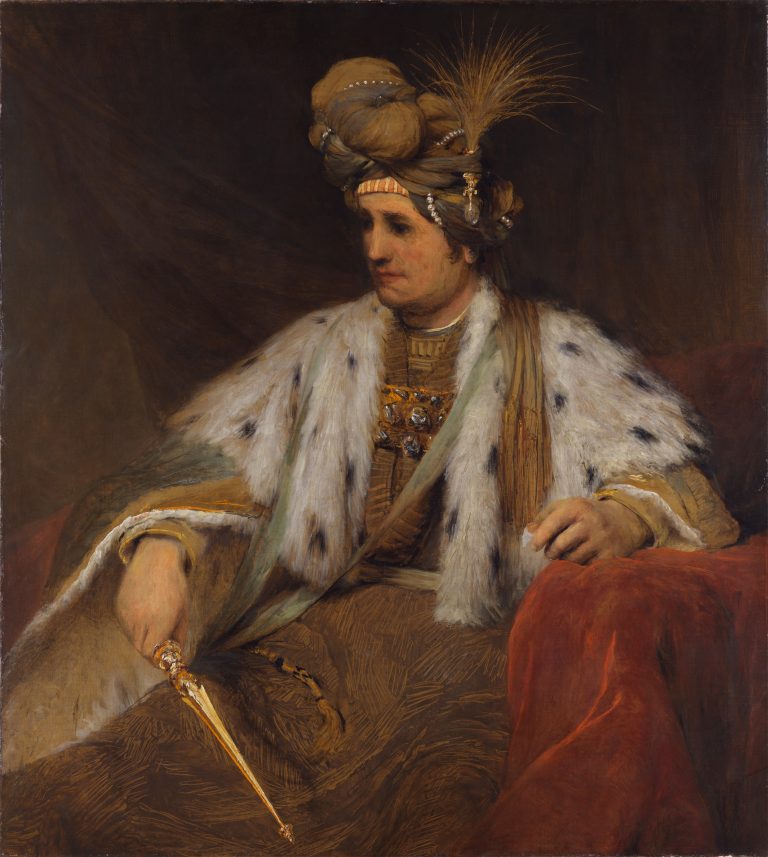The sumptuously dressed Oriental ruler in Arent de Gelder’s imposing, life-sized painting has all the attributes of power, including an exotic turban elaborately wound and adorned with pearls, a costly ermine cloak, and a gold scepter, but his demeanor is that of a man weighed down by worldly concerns. With his eyes lowered and darkened in shadow and a facial expression that is resolute but muted, he stares off to his right, undoubtedly reflecting deeply on issues of moral and ethical consequence. The specific matters that have come before this potentate are not known, largely because painting is a fragment of a history painting that was originally much larger. At some point the canvas support was cropped on the left.1 It is likely that this ruler is an Old Testament king.2 Arent de Gelder’s King David, now in Amsterdam, which can be dated to 1680–83 (fig 1), and the figure of Ahasuerus in Ahasuerus and Haman of 1682–85, now in Birmingham (fig 2), wear comparable cloaks of royal distinction.3
One can deduce the identity of this particular Old Testament king through a consideration of his age. For example, his youthfulness makes him unlikely to be King David. As in De Gelder’s Amsterdam painting (fig 1), King David was traditionally portrayed as a bearded old man after his accession to the throne. It is also unlikely that the painting depicts the Persian king Ahasuerus, despite the fact that he was often portrayed holding a golden scepter, since he was generally shown as an elderly man with a beard (fig 2).4 De Gelder’s painting Esther’s Banquet of ca. 1680 in Dordrecht, in which the king is younger and beardless, cannot serve as a point of reference, because his face is largely a recent reconstruction.5
The Old Testament figure’s youthful appearance and beardlessness suggest that he is King Solomon. It is conceivable that the complete scene represented Solomon passing judgment on two women, both of whom claimed to be the mother of the same child (1 Kings 3:16–28). In this scene Solomon is traditionally portrayed as a young king on the throne, frequently passing judgment while pointing down with his scepter. There are numerous depictions of this composition. Worthy of mention is an engraving by Boëtius Adamsz Bolswert after a lost painting by Peter Paul Rubens (1577–1640) (fig 3). Another prominent example would have been known to De Gelder, namely, the marble relief by Artus Quellinus the Elder (1609–68) in the tribunal (vierschaar) of the Amsterdam town hall built between 1650 and 1664 (fig 4).
De Gelder, Rembrandt’s last pupil, remained faithful to his master’s late expressive style throughout his career, even in the face of the prevailing classicizing fashion. Although his sense of form was less stable than Rembrandt’s, his palette was more adventurous and colorful, partly through his effective use of colored grounds and other under layers of paint. Arnold Houbraken describes how De Gelder varied his application of paint to depict different textiles and patterns: he “scratched out the appearance of the embroidery or the threads of the fringe with the butt of his paintbrush, or by any means possible, if only it furthered his aim; and it is astonishing how natural and powerful such an approach sometimes looks from a distance.”6 The present painting beautifully exemplifies this technique, for such scratching into the wet paint, both broad and thin, occurs everywhere on the figure’s clothing. De Gelder’s vigorous technique of scratching is particularly evident in Solomon’s brown robe, where it both enlivens its form and gives it structure. De Gelder’s characteristic warm palette and his richly varied application of paint have an amazing ability to capture the surface qualities of different materials in a suggestive but convincing way.
It is difficult to date this picture precisely on the basis of stylistic comparison because De Gelder dated few works from the 1690s and later. His Self-Portrait as Zeuxis in Frankfurt (fig 5) displays certain similarities to Old Testament Figure, Probably King Solomon with regard to palette and brushwork, which suggests a date of around 1685–90.
